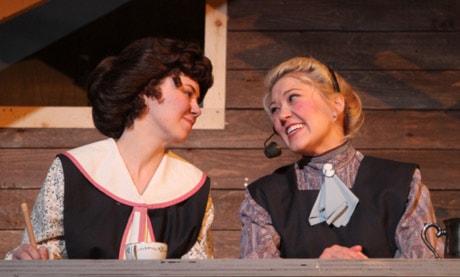Unity (1918) is a quirky play about a war and an epidemic that somehow manages to be darkly funny and not overly bleak.
A corpse passes wind while being transported in a wheelbarrow in this sometimes laugh-out-loud drama that shocked and occasionally appalled the audience when it opened on Thursday in Studio A of the Red Deer College Arts Centre.
The undertaker in the RDC Theatre Studies production is a 14-year-old Icelandic girl, who unofficially inherited the job when her uncle died.
Among the play’s other colourful characters is a flirty teenager who becomes a self-proclaimed doomsday prophet, furiously adding and dividing dates to come up with appropriately apocalyptic numerology.
A meddlesome telephone operator who listens in and provides a running commentary on calls was also created by playwright Kevin Kerr, as was a just-widowed farmer who randomly pitches marriage proposals to any girl who might have him.
This Governor General Award-winning play about the period of Canada’s history when the Great War was winding down and the Spanish Flu epidemic running its course has people dropping dead for all kinds of reasons — including drink, childbirth and farming accidents.
But there’s something about waiting for a deadly influenza to arrive on their doorstep that shakes the residents of Unity, Sask., to their very core. A preventive quarantine is imposed by the town in a futile effort to keep the flu at bay. But returning soldiers are helping spread the scourge to even the remotest communities.
When the first battle-scarred soldier arrives in Unity from the killing grounds of Europe, Beatrice says, “Today on the train, the world started to return . . . but not the way I thought,” continues the innocent farm girl who narrates Unity (1918) — for nobody recognizes the soldier.
Not only has he been blinded by burns, but he brings news of a strange sickness that’s been wiping out whole families in Eastern Canada and Europe.
Up to then, the biggest problem faced by Beatrice, played by Sarah Hemphill, and her friend Mary (Jillian Tallas) is being separated from boys they like.
Mary’s soldier boyfriend writes her letters promising marriage when the war ends. And Beatrice fantasizes about the same kind of happy ending with her crush, Glen.
But naive Beatrice is shy about matters of the heart, even compared to her sister Sissy (Lisa Daniels), who is much more forward in pursuing the hired hand, Michael.
Beatrice marvels at how freely Sissy can interact with Michael, “like it’s easy to be near him, like her heart isn’t cracking open. . . .”
Bea is soon to learn there’s little room for romantic fancies when her known world is falling apart.
This production, capably directed by Tanya Ryga, benefits from a great cast of young actors, including Hemphill, Daniels and Tallas, who bring youthful vitality to their roles, creating believable characters who could have lived 100 years ago.
Katie Orsten makes a memorable Sunna the undertaker, who remains an outsider years after moving to the tight community of Unity.
Other standouts are Jordan Bartsch in the dual roles of Michael and Glen, and John Dyck as the wounded soldier Hart.
Local set designer Kalon McClarty used his boundless imagination to create Saskatchewan’s wide horizons in the limited Studio A space.
If there’s a message in Unity (1918), it’s that human connection and kindness are necessary, even in the darkest moments — or maybe especially in the darkest moments.
And love can bloom at the end — maybe it can even transcend.
lmichelin@www.reddeeradvocate.com
